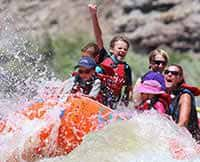Five Stories, Five Boats: White Water Rafting Down the Grand Canyon
My first exposure to white water rafting down the grand canyon was as a 17 year old "extra swamper" on a motorized J-Rig raft. Maybe that skews my perspective to favor the J-Rig, but it does give me a perspective to build upon. Now, if all I had ever tried was a motorized raft, never experiencing other methods of challenging the Colorado River white water rapids in Grand Canyon, you'd be allowed to skewer me as downright skewed. But my experience is enlightened thanks to an amazing community of rafting guides and outfitters in Grand Canyon, nurtured in part by the Grand Canyon River Guides association.
First I have to explain that if anyone tries telling you that there is sour division about motors vs. rowing in the Grand Canyon, they are oversimplifying the ecosystem that exists amongst the guides and outfitters. Competition between different companies is natural, but it feels more like community. Every spring, the Grand Canyon River Guides association holds a Guides Training Seminar (GTS) on land and on the river. These guides-only river trips alternate hosting responsibilities for the trip among the sixteen different outfitters in Grand Canyon. This is a flotilla of otherwise competing rafts and rafting companies floating, camping and running rapids together for the common cause of being better guides, better interpreters of the experience of Grand Canyon to guests, and of course advocating for the amazing resources unique to Grand Canyon. These trips run though the canyon at the pace of human power, but rely on motor raft support. One year, as a guide for Western River Expeditions, I had the opportunity to participate and co-captain the J-Rig support boat. These GTS trips offer a rare glimpse of different and competing outfitter's rafts both in camp and on the river.
The GTS trips only help to enhance the already symbiotic relationship between motor and non-motorized trips - and even private vs. commercial trips in Grand Canyon. When $@#! hits the fan, everyone works together. Those motors are appreciated when they are needed in such situations. When private trips run low on ice on their twelfth day in the canyon, and a motor rig comes floating by, you can be sure they are grateful when we offer them a few spare blocks of ice. The list goes on and on.
Five Kinds of Boats Used for Grand Canyon White Water Rafting
Oar Rafts - Having witnessed the almost appalling force with which the J-Rig smashes into the final wave in House Rock rapid, and watching from the very back of the boat the way the thirty-seven foot long boat climbs vertically up the steep waves of Hermit Rapid, I was more than intimidated about the prospect of taking on those same waves from a much smaller row rig or paddle raft. Drifting in the calm water above the first really big rapid on the Colorado River in Grand Canyon, House Rock Rapid, I was very afraid. I was a newbie at the oars for one thing, but I was imagining this small cargo boat smashing into the final wave in House Rock with the same force as I'd seen on the J-Rig. I knew I was only human and that scared me all the more. I bailed out and let my more experienced cargo-boat compatriot take us through. She did, while laughing and explaining that I would soon see that the waves, the rapids, are simply different in a smaller boat.
She was right. If you put it to a discussion on physics, I'd guess it has everything to do with momentum. With very little forward momentum, a wave doesn't necessarily crash against the boat as much as it passes under the boat. Some waves crash differently, so forward momentum is needed to punch through the wave. For waves or "holes" that crunch and stop any forward momentum, a small oar and paddle powered raft can easily skirt the edges. Most times those kinds of "crunchy" holes are avoidable. Lava Falls does make it hard to avoid them though!
Dories - I have always admired the curved lines of the dories. They are elegant wooden boats that pivot far better than any rubber raft. Did I mention they are made of wood? Knowing the river, and how to make your move in it, is a thrill beyond description - when you do pull it off successfully that is!! There's nothing like perfecting the run in wooden boats that offer very little mercy when it comes to banging into rocks or "rumbling" over them! On the aforementioned GTS trip I had the opportunity to row Brad Dimock's dory through Grapevine rapid. Brad Dimock, a heckuva boatman and story-teller, asked who wanted to give it a try. Climbing into the helm of his prized wooden dory above Grapevine rapid felt like rock climbing without a rope. It was an almost surreal thing to have Brad (a boatman of 26 years at that time) calmly in command over my shoulder telling me what to look for, when to stroke with the left or right oar, and what would happen when I did. I knew Grapevine Rapid, but not from the perspective of a Dory, until then. The run was smooth, memorable, and fun. I could tell he knew that river and each of its rapids in an intimate and very nuanced way. I was glad he shared that perspective.
Paddle Rafts - Hance Rapid is a rock-strewn mess, full of gnarly holes that swallow motor rigs and damage motors if you're in the wrong place. On this GTS trip in early spring the water was flowing high enough for our J-Rig support boat to run through those holes. I was ill-prepared for the cold and wet, but I was curious how paddle rafts make it through rapids like Hance, so I jumped in for the ride. Paddle in hand, we took the same route the motor rigs usually take: tucking behind the big boulder at the top to eddy out, (or rest in the calm water) in "the duck pond" to get a glimpse of where to paddle next. Maybe because we were occupying the duck pond, and because the higher water flow meant less crunch on the holes, Mark Pierce took an empty (no passengers) J-Rig down the gut through the holes of Hance Rapid. We watched with the perfect view from the duck pond. It was spectacular! The load in the middle came loose after a few blistering hits on the riderless J-Rig. That J-Rig (and Mark) got one memorable ride! Meanwhile back on the paddle boat... With expert commands shouted by our paddle captain, we made it through Hance rapid with nothing memorable happening at all - except that it began snowing mid-rapid. I was in the paddle raft freezing my pechugas off with large snowflakes coming down in the early April weather. I was slightly hypothermic, and remember wishing I could get to the J-Rig "home" and put some warm clothes on on that large stable raft! But paddling kept me warm until I could change at camp. The best part of being in a paddle raft is pulling off the teamwork required to do it right. It takes a keen ear, a strong quick stroke, and a willingness to swim! But when it all goes right, it's perhaps one of the most rewarding things you can do in river rafting. You literally are part of making it go right, or suffer the consequences!
Another story of paddle rafts in the Grand Canyon... One warm summer day guiding a J-Rig full of guests, we emerged victorious and cooled off from a great run through Horn Creek rapid. We saw something floating up ahead and fished it out of the water. A paddle. Then another, and another. Then a helmet... We began fearing what would come next! Soon we came upon a lone paddle raft that had very apparently suffered the worst consequences Horn Creek could serve up! Their helmets were ajar, half their paddles were missing, and the paddlers (guests who had just hiked down that day from the rim at Phantom Ranch) looked nothing short of shell shocked. They were most definitely showing signs of trauma! I swear a few of the paddlers, looking like "half-drowned rats", would have given anything to climb aboard our giant stable J-Rig raft and dry out for a while. Their guide, the paddle captain, tried making the best of the situation on behalf of her guests. As we handed them the paddles and helmets, she said "That right side is BIG!" I laughed and said it looked like they had everyone accounted for. She confirmed that and then added that "Horn Creek is a heckuva warm up rapid for first-time paddlers!" It took me a minute to absorb what she'd just said. These guests had just started their rafting trip from south rim of the Grand Canyon, met their paddle captain at Phantom Ranch on the shores of the Colorado River and gotten only a few miles of white water paddling experience before being challenged to paddle through Horn Creek rapid (an 8 on the Grand Canyon scale of 1-10). Their first rapid to paddle through on the first day of their 5 or 6 day expedition was Horn Creek?!! I give props to the paddle captains that take on that! (I'd literally give props to them if they had a motor). One of the mantras our paddle captains use up in Cataract Canyon - further upstream in the Utah portion of the Colorado River - is "Embrace the chaos!!!" as they paddle into the large white water rapids found in that canyon. After handing over the fetched gear from this Horn Creek embattlement, I offered to tow them to catch them up to their group, but she said her group would be stopping before the next rapid and they'd catch up to their group. Nothing is guaranteed when whitewater rafting in the Grand Canyon. Even with large motorized pontoon rafts, things can go wrong. But the community pulls together whenever it's our turn.
Duckies (aka Inflatable Kayaks) Later in the same year, I had a chance to run an inflatable kayak through nearly every significant rapid in the Grand Canyon. By the time Lava Falls came around, I was adequately confident that we'd survive! Just in case, my guide friend and I doubled up on life jackets, scouted the rapid, said a prayer, and then put on a show. We had scouted Lava Falls for this run, but neither of us were very confident that we could pull off the move we needed to make. The plan was to break through the lateral wave that funneled into the "V-Wave". We gave ourselves about a 20% chance of breaking through that lateral to relative safety below the ledge hole. The other 80% of our chancy run would put us sideways into the swallowing V waves and swimming the rest of the way through the length of Lava Falls. We could only hope to hold our breath that long. But, Lo, and Behold! We lined it up, and had the momentum exactly right. We had fought off the strong hydraulics that swirl off the chunk of basalt on the right bank, making sure we didn't get too far left or middle and pour ourselves over the 15 foot ledge hole that swallows the biggest boats in the canyon if they are in the wrong place. We paddled hard to give ourselves momentum to punch through the lateral wave and into the calmer whitewater below the ledge hole. To our utter amazement (and everyone else's watching), we did the run precisely as we'd planned it. We barely paddled the rest of the way out of the rapid and were home free. The feeling was amazing. It only lasted so long though, as our next raft through (the cargo boat) overturned, or flipped, in the bottom waves near the Big Bertha rock, as we called it. I'll never forget how the fellow river community, watching the carnage and amazing duckie run, swooped in below Lava to help flip the cargo boat back over with cheers all around.
Western River offers plenty of other trips in Utah, Idaho and Oregon - and Costa Rica, where you can paddle your own duckie (inflatable kayak) or experience the team thrill of a paddle raft, or let the guide row you through on an oar boat! They're all fun.
Motorized J-Rigs and S-Rigs in Grand Canyon whitewater J-Rigs were built by Western River's founder Jack Currey specifically for the guests to experience the adventure and thrill ride of the exceptionally large waves of the Colorado River on a Grand Canyon white water trip. If you want the full scoop on what makes the J-Rig great, take a look at Western's J-Rig page with full descriptions and video testimonials from guests and guides. Many of Western's guests are so beholden to what the J-Rig (and the Western way) offers, that they can hardly fathom white water rafting in the Grand Canyon with anyone but Western. That's part of why we sell out in the Grand Canyon each year. What Jack Currey found in the 1960's, as they experimented with the J-Rig design was that they could see much more of the Grand Canyon within the typical one-week holiday that most guests have - this includes time to explore up side canyons now made famous by a thousand postcards and Kodak moments over the years. Ride and safety were top of mind for Jack. He saw other motorized rigs (the S-Rig and Georgie's "Triple-Rig") and quite frankly created something that was much, much better for the guest experience. Experiencing rapids on a J-Rig is an experience found nowhere else (except in Cataract Canyon, Utah). Bottom line is that the canyon itself is enough of an overwhelming experience, and six or seven days on a motorized vessel allows you to see and experience the best of it with comfort both on and off the river at camp. The J-Rigs and S-Rigs are motorized, or powered by a 35 horsepower four-stroke outboard motor from the rear behind the noise-dampening cargo piles. While noise is a factor, compared to the creak of oar-locks, the decibels really are quite minimal.
The difference between an S-Rig and a J-Rig? I never got the chance to ride a rapid from an S-Rig. From what I have been told, the frames on S-Rigs are solid from bow to stern (no flex points), and therefore an s-Rig tends to punch through the middle of the waves, rather than ride and flex over the waves like a J-Rig is built to do. From my observations of the S-Rig setup, there is no variety of seating other than left side or right side with your back against the duffle pile. Perhaps S-Rigs were built primarily for duffle and cargo (motor support) more so than for the guest experience.
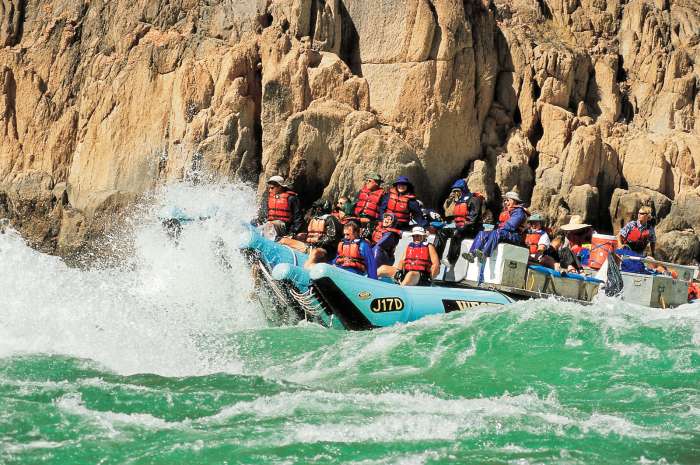
Related Trips
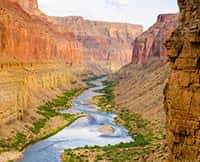
Grand Canyon Rafting Trips
Experience a 3 to 7 day expedition filled with whitewater excitement, spectacular waterfalls waterfalls and starry nights.

Middle Fork Salmon Rafting Trip
More than 100 whitewater rapids, natural hot springs, waterfalls and camping in gorgeous mountain meadows.
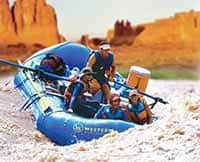
Cataract Canyon 4 Day Trip
Experience 4 Days through the heart of Canyonlands National Park.

Costa Rica Vacation Package
Experience the legendary Pacuare River and a world-class, riverside eco lodge.

3 Day Grand Canyon River Trip
Raft 100 miles on the Colorado River through Grand Canyon.
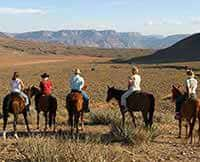
Grand Canyon 4 Day Tour
Combine your Grand Canyon rafting adventure with a day and night at a working cattle ranch.
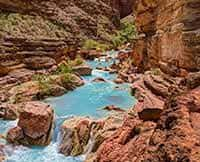
Grand Canyon 6-7 Day Vacation
A unforgettable journey of 188 miles from Lake Powell to Lava Falls.
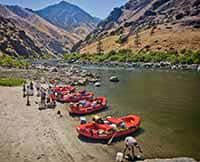
Hells Canyon Rafting Trip
The deepest river gorge in North America and some of the largest whitewater rapids in the Pacific Northwest.
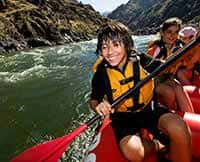
Lower Salmon 5 Day Rafting Trip
Huge sandy camping beaches, rich history, beautiful waters and choices of oar boat, paddle and inflatable kayak.

Main Salmon Rafting Trip
The "River of No Return" boasts dense pine forests, granite mountains and abundant wildlife.
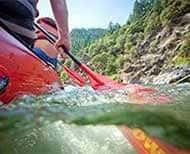
Rogue River Lodge to Lodge Trip
One of the most unique rafting vacations in the world. Astounding wildlife, scenery and historic river lodges each night.


